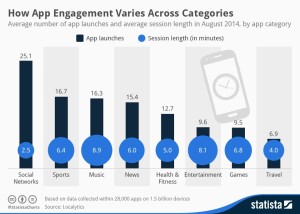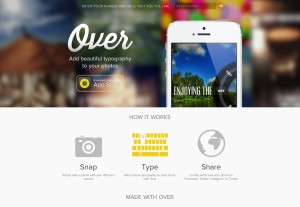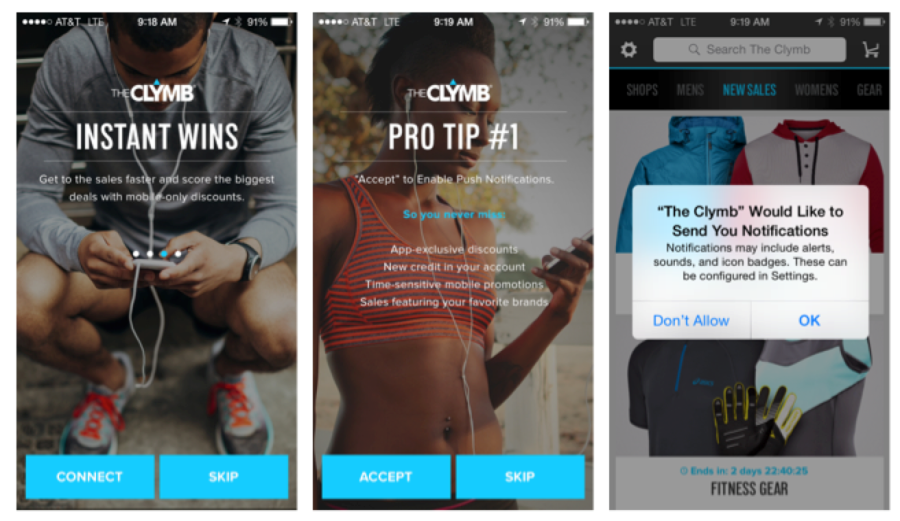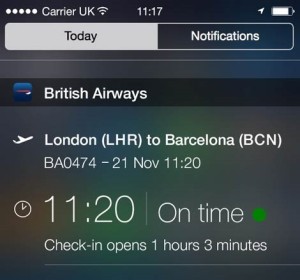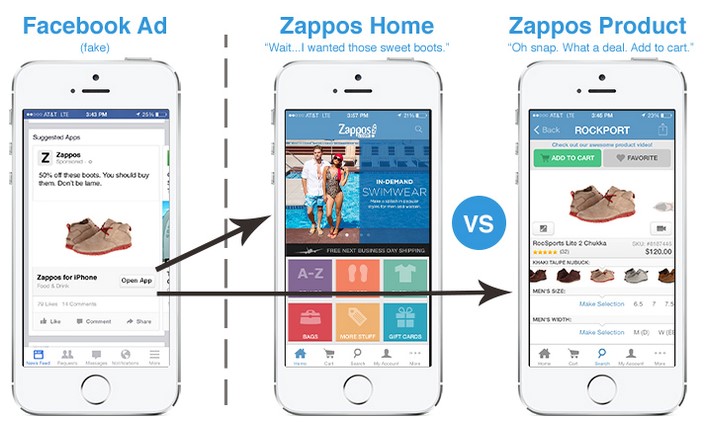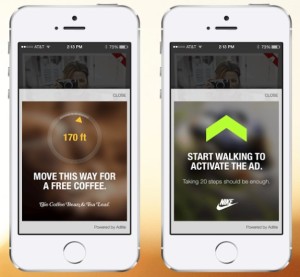We have all been there…
You have done the hard work. You have meticulously taken care of the Mobile app development and designing part. You have been very careful regarding the user experience. And, you have marketed your app very well.
With a sigh of relief, your app’s in the market.
But, when you look at the analytics, you notice that despite a fair enough number of downloads, your app fails to engage customers for as long as you’d hoped, and that user retention is disappointing.
Is engaging users really that big of a challenge? And what about retaining them?
It doesn’t really need to be so hard.
A great app experience is like sipping the finest coffee to kick start your day.
You love coffee. You love its smell, and the taste.
You know that you want to keep it going on a regular basis.
Gradually, the coffee becomes an integral part of your daily mornings. It just makes its way in.
An engaging app is quite similar. You just want to use it over and over and over.
On the other side…
An app that fails to engage users is like having the worst coffee; laden with hundreds of calories in cream, and sugar worth a dozen pastries (totally unwanted ingredients).
At some point in life, we have all had one such nasty coffee. It tastes bad, really bad. To make it worse, you don’t feel like having another one for the whole day.
In the end, all you want to do is to get rid of that unpalatable feeling.
This is exactly the same for mobile app engagement. Failing to engage users is like failing to please a coffee connoisseur. No coffee lover would ever try another coffee from a shop that failed to tantalize their taste buds, and in a similar manner, users never open apps that are unable to amuse them. In the blink of an eye, the app is uninstalled for good.
So, how do you brew your app to perfection? What perfect blend of ingredients is required to keep users hooked to your app?
You’re about to learn of the 5 most important strategies to drive continuous mobile app engagement.
1. ‘Opt-In’ For Push Notifications
A recent research by Kahuna shows that push opt-in rates vary widely across industries. Ridesharing apps like Uber are among the top when it comes to opting for push notifications, while social apps rank at the bottom.
When we render push notifications as the primary method of engaging users and retaining them, we must look at the huge gulf between how users many opt-in and opt-out, based on the product category. Here’s a stat from Kahuna:
- In some product categories, 60% users turn off push notifications (Social, News & Media, Travel, etc.)
- In other categories, only about 20% turn off push notifications (Ridesharing, Food & Beverages, Financial Services, etc.)
Social apps and others in the same category rank lower because of the huge number in which they are available, and each app trying to push through its content to engage the users with them. However, the plethora of notifications becomes distracting and annoying, and people thus opt-out of these.
Here’s a look at the state of iOS push opt-in rates. Since Android apps don’t seek user permission for push notifications, enablement rate data is available only for iOS apps.
It is evident from the figure that ridesharing apps have an approximate opt-in rate at 79% while social industry has a meager 39%. Apps with a higher percentage are able to engage and retain users twice more than low-performing apps, and they are also capable of generating twice the revenue.
Only relevant push notifications are acceptable to users, and those that offer value.
Users today are more selective towards what information they receive, and it is pertinent for apps to understand consumer’s behavior of choice and gain their trust, if they are to push their content through. Based on app categories, users have developed pre-conceived notions about the nature of notifications.
Apps that push informative notifications have an edge over others. Uber, for example, sends notifications that inform the user of how long their ride will take to reach them, or that the ride has arrived.
Building positive associations through push notifications is the key to success, just as most of the ridesharing, food & beverage, and financial services apps do.
On the other hand, there’s Facebook, or FarmVille. Facebook is a social media platform, and FarmVille is a virtual farm life simulator.
These apps have been around for a lot of time. And, there’s no doubt, these apps have been highly successful.
But, the problem with these apps is that they push notifications through very frequently, notifying you of a comment on a post you follow, or that your goats are ready to be milked (duh!).
Okay, this is a nice feature, but where’s the value in these notification?
Nowhere!
It only adds to the ever increasing, useless heap of notifications of which I have no need. As such, most people turn off the notifications on their phones.
So, to prevent your app from becoming a bane for the user experience, you need to save your app from automatically falling into the category that suffers from low opt-ins.
Here’s a 3-step strategy that can help you influence user opt-in rates, and multiply user engagement:
-
First impression is vital
Your app needs a clear and informative landing page that informs users of the apps top features, and how the app will utilize push notifications. This landing page should only pop up the first time a user opens the app.
Users are more likely to opt for push notifications when they know what value your app delivers, and how push messages will enhance their experience.
It is very important to ask your user to opt-in, but it is more important to time your question appropriately.
Users are more likely to press the ‘don’t allow’ button if they are not familiar with how an app works. Once users understand what value they are getting, there’s a fair enough chance that they will opt-in for notifications from your app.
Remember, you only get one shot at this, be patient.
Sticking to the basics will enable you to improve user experience, and increase push opt-in rates dramatically.
-
Develop an ongoing relation with users
Think of the push notifications as a communication channel between you and the user.
Make sure notifications are personalized and targeted, and add value to the user experience. This will increase chances that users will not opt-out, or uninstall your app after getting annoyed.
2. Make social sharing convenient
Users don’t just share news and ‘what’s-on-your-mind’ posts, but there’s a whole lot of other stuff they want people in their social networks to know, such as gaming high scores they are proud of, or milestones achieved in a health & fitness app.

Facebook and Twitter are the most popular platforms for instantly sharing such information. Sharing also provides exposure to your app, and drives new users towards it.
Sharing should be convenient for the users, and should add to their experience. Easier sharing conveys your apps value quicker, and facilitates long-term engagement with the user. Users are also able to see immediate usefulness when they develop a positive relation with the app.
There’s one important thing to keep in mind here.
While social sharing should be readily available in your app, it shouldn’t be intrusive, and must not interfere with the user experience.
3. Track event-based interactions
Users complete a series of actions or ‘events’ during their session on an app. These actions are easily trackable with app analytics.
The data gathered here gives you insights into which screens engage your users the most, and ‘convert’. User actions are reflective of what interests them or what they find useful.
The time they spent on a page, and the actions they complete there, help you target the users to re-engage after they have completed an action. You can do this by pushing through personalized and targeted in-app messages.
A shopping cart for example, requires a user to add a product to the cart, and complete a checkout later. This is where analytics play a key role. In only a few seconds, you can grab the attention of users by a customized message, tailored to their interests, and redirect them to a similar product/offer.
4. Use deep linking with push and in-app messages
Using URLs to link specific content within your app is a very effective means of keeping your users engaged.
URLs are normally viewable across all platforms, from web to mobile, to social media.
But the concept of deep linking, i.e. using URLs to link content, is slightly different on mobile. Links are meant to ensure that users are redirected to another screen within your app.
It isn’t a means of launching your app on the home screen, but takes the users through mobile ads, in-app messages, or push notifications, and to a similar/relevant screen within the app.
Deep linking is important in following regards:
- Saves valuable time while searching for relevant screens
- Engages the users immediately with the right content, at the right time
- Eliminates navigational confusion
Taking your users on a clear and easy to follow in-app path improves app quality, minimizes user difficulties, and increases conversion chances of your app marketing campaigns.
5. Offer mobile specific rewards
Believe it or not, incentives are the greatest force driving human behavior. Talking psychology? No! It’s a crazy fact!
According to a rough estimate, about 50% people download apps to receive special offers and discounts. Remember ‘Free Poker Chips’? Exactly!
If your app analytics show a fair number of passive users who have not engaged in quite a while, it could possibly be because they’re missing ‘mobile exclusivity’.
To re-engage such users, you could put up a lucrative, mouth-watering, once off exclusive rewards offer, or a series of offers over a limited time period.
If done properly, a large portion of that hibernating user-base is bound to come looking for their share of the cake.
Key Takeaways:
- Use push notifications to engage users
- Push notifications should be personalized, and deep linked appropriately
- Recognize unengaged users through analytics, and cater to their needs
- Time your ‘opt-in’ request perfectly as it is crucial, and of course, is your one and only shot
- Allow ready, convenient social sharing
- Use rewards and offers as bait to lure disconnected users back (and make sure the drink’s on you)
